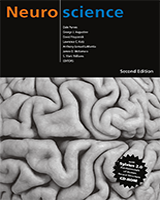By agreement with the publisher, this book is accessible by the search feature, but cannot be browsed.
NCBI Bookshelf. A service of the National Library of Medicine, National Institutes of Health.
Purves D, Augustine GJ, Fitzpatrick D, et al., editors. Neuroscience. 2nd edition. Sunderland (MA): Sinauer Associates; 2001.

Neuroscience. 2nd edition.
Show detailsOverview
The somatic sensory system has two major components: a subsystem for the detection of mechanical stimuli (e.g., light touch, vibration, pressure, and cutaneous tension), and a subsystem for the detection of painful stimuli and temperature. Together, these two subsystems give humans and other animals the ability to identify the shapes and textures of objects, to monitor the internal and external forces acting on the body at any moment, and to detect potentially harmful circumstances. This chapter focuses on the mechanosensory subsystem; the pain and temperature subsystem is taken up in the following chapter.
Mechanosensory processing of external stimuli is initiated by the activation of a diverse population of cutaneous and subcutaneous mechanoreceptors at the body surface that relays information to the central nervous system for interpretation and ultimately action. Additional receptors located in muscles, joints, and other deep structures monitor mechanical forces generated by the musculoskeletal system and are called proprioceptors. Mechanosensory information is carried to the brain by several ascending pathways that run in parallel through the spinal cord, brainstem, and thalamus to reach the primary somatic sensory cortex in the postcentral gyrus of the parietal lobe. The primary somatic sensory cortex projects in turn to higher-order association cortices in the parietal lobe, and back to the subcortical structures involved in mechanosensory information processing.
- Cutaneous and Subcutaneous Somatic Sensory Receptors
- Mechanoreceptors Specialized to Receive Tactile Information
- Differences in Mechanosensory Discrimination Across the Body Surface
- Mechanoreceptors Specialized for Proprioception
- Active Tactile Exploration
- The Major Afferent Pathway for Mechanosensory Information: The Dorsal Column-Medial Lemniscus System
- The Trigeminal Portion of the Mechanosensory System
- The Somatic Sensory Components of the Thalamus
- The Somatic Sensory Cortex
- Higher-Order Cortical Representations
- Summary
- Additional Reading
- The Somatic Sensory System - NeuroscienceThe Somatic Sensory System - Neuroscience
- APTX [Macaca fascicularis]APTX [Macaca fascicularis]Gene ID:102135987Gene
- NTNG1 [Mauremys reevesii]NTNG1 [Mauremys reevesii]Gene ID:120371056Gene
Your browsing activity is empty.
Activity recording is turned off.
See more...